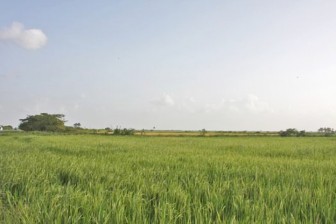Guyana’s annual rice production is set to exceed 400,000 tonnes for the second time in its history and according to Guyana Rice Development Board (GRDB) General Manager Jagnarine Singh the projected landmark is owing to a combination of circumstances, including the emergence of new, more productive varieties of paddy in recent years, the application of improved technology to the industry, significant improvements in drainage and irrigation and a more aggressive approach to rice cultivation on the part of the country’s 8,000-odd rice farmers.
Last year, the industry yielded 402,450 tonnes of rice valued at US$173,259,722.
Singh told Stabroek Business that the first crop for 2012 yielded 210,000 tonnes of rice and there was every indication that overall production would again exceed 400,000 tonnes.

He pointed to written assessments that this was “the third year in succession we have recorded a positive growth in this sector” and again surpassed sugar “as the most important agricultural industry in Guyana”. Singh noted that the improved scientific support which the GRDB has been able to provide to the rice industry was because of, among other things, its ability to train and retain highly qualified personnel, a problem which has dogged the sugar industry for years.
GRDB Extension Services Manager Kuldip Ragnauth told Stabroek Business that communication with rice farmers across the country had improved significantly. He said the introduction of the Farmers’ Field School, an initiative which enables farmers to gather at pre-determined rice-growing locations to undertake laboratory-type investigations of problems associated with cultivation had been designed to allow for greater involvement by farmers in contemplating, and addressing challenges on a “need to basis.”
According to Singh, “but for considerations associated with a shortage of labour, local rice production could probably reach 500,000 tonnes annually. Despite the application of technology there are some things that simply cannot be done in the absence of an adequate labour force,” Singh said.
Figures made available to this newspaper by the GRDB indicate that since 2008 both rice production and earnings from the industry have recorded a steady annual increase.
Last year, Guyana exported 305,382,000 tonnes of rice, while for this year so far rice exports have reached 143,674,000 tonnes.
Alluding to the continually improving fortunes of the rice industry, Singh said that more farmers are returning to the land, though he conceded that expanded rice cultivation coupled with the current housing drive was depleting pasture land necessary for the development of the dairy industry.
Just days ago, Agriculture Minister Dr Leslie Ramsammy announced that so far this year 45,000 tonnes of rice have been shipped to neighbouring Venezuela, by far this year 45,000 tonnes of rice have been shipped to neighbouring Venezuela, by far Guyana’s largest rice market.
Despite his upbeat projections for the immediate-term future of the rice industry, Singh said it was no secret that it could face serious challenges in the future. According to the GRDB General Manager, the demand for rice in Europe is currently being sustained, in some measure, by the current economic crisis in that region. He said austerity measures arising out of the crisis had resulted in rice becoming a cheaper option to pastas and other flour products. “It is likely that once Europe emerges from that crisis we could see a reduction in demand for rice. In addition to that competition from cheaper rice exports from the Far East could also see our European rice market [reduced],” Singh said.
Singh said that the GRDB had not lost sight of the importance of aggressively seeking new markets and he named northern Brazil, Haiti and Central America as possibilities. He disclosed that the Brazilian Agricultural Research Corporation EMBRAPA had indicated a preparedness to provide technical support to the local rice industry. He also said the GRDB’s response to the imperative of enhancing the profitability of rice, included examining the potential of possible earnings from value-added pursuits.





